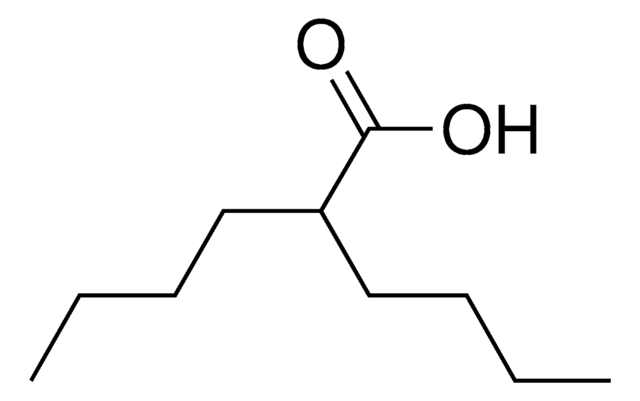W270601
2-Methylheptanoic acid
≥97%
About This Item
Produits recommandés
Source biologique
synthetic
Niveau de qualité
Qualité
Halal
Kosher
Agence
meets purity specifications of JECFA
Pureté
≥97%
Indice de réfraction
n20/D 1.425 (lit.)
Point d'ébullition
140 °C/30 mmHg (lit.)
Densité
0.906 g/mL at 25 °C (lit.)
Application(s)
flavors and fragrances
Documentation
see Safety & Documentation for available documents
Allergène alimentaire
no known allergens
Propriétés organoleptiques
green; cheesy; waxy
Chaîne SMILES
CCCCCC(C)C(O)=O
InChI
1S/C8H16O2/c1-3-4-5-6-7(2)8(9)10/h7H,3-6H2,1-2H3,(H,9,10)
Clé InChI
NKBWMBRPILTCRD-UHFFFAOYSA-N
Catégories apparentées
Description générale
Clause de non-responsabilité
Mention d'avertissement
Warning
Mentions de danger
Conseils de prudence
Classification des risques
Eye Irrit. 2 - Skin Irrit. 2 - STOT SE 3
Organes cibles
Respiratory system
Code de la classe de stockage
10 - Combustible liquids
Classe de danger pour l'eau (WGK)
WGK 3
Point d'éclair (°F)
>230.0 °F
Point d'éclair (°C)
> 110 °C
Équipement de protection individuelle
Eyeshields, Gloves, type ABEK (EN14387) respirator filter
Certificats d'analyse (COA)
Recherchez un Certificats d'analyse (COA) en saisissant le numéro de lot du produit. Les numéros de lot figurent sur l'étiquette du produit après les mots "Lot" ou "Batch".
Déjà en possession de ce produit ?
Retrouvez la documentation relative aux produits que vous avez récemment achetés dans la Bibliothèque de documents.
Notre équipe de scientifiques dispose d'une expérience dans tous les secteurs de la recherche, notamment en sciences de la vie, science des matériaux, synthèse chimique, chromatographie, analyse et dans de nombreux autres domaines..
Contacter notre Service technique








